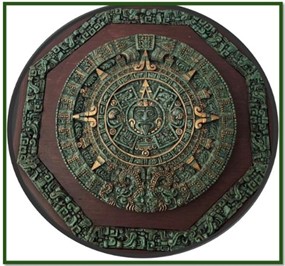Mayan Calendar
The Mayan civilization,
renowned for its impressive architectural feats and deep understanding of
astronomy, left behind a complex and intriguing timekeeping system known as the
Mayan Calendar. This calendar, far from being a simple tool for tracking days
and months, was deeply intertwined with their cosmology, religion, and daily
life. Let’s explore this ancient calendar’s intricacies and its significance.
The Components of the Mayan
Calendar
The Mayan calendar is not a
single calendar but a system of interconnected calendars, each serving a
different purpose:
The Tzolkin (Divine
Calendar): This 260-day calendar was used for ceremonial purposes
and divination. It consisted of 20-day signs, each with a unique glyph and
meaning, combined with 13 numbers.
The Haab (Civil Calendar): This
365-day calendar was closer to our modern solar year and was used for
agricultural and daily life purposes. It had 18 months of 20 days each, plus a
five-day unlucky period called Wayeb.
Wayeb is five days after the
Haab, the Mayan solar calendar. When the boundaries between the living and the
underworld were thin, Wayeb was considered a time of danger and bad luck.
The Calendar Round: This
combined the Tzolkin and Haab calendars, creating a 52-year cycle. Each day in
this cycle had a unique combination of Tzolkin and Haab designations.
The Long Count: This
calendar was used to track more extended periods, record historical events, and
calculate dates far into the past and future. It was based on a cycle of
approximately 5,125 years.
Cosmology and Religion
The Mayan calendar was deeply
rooted in their cosmological beliefs. They believed that time was
cyclical, with each cycle ending in destruction and renewal. The Long Count was
essential in tracking these cycles, and elaborate ceremonies and rituals marked
the end of each cycle.
The Tzolkin calendar, with
its 260 days, was linked to the gestation period of humans and the agricultural
cycle. Each day was associated with a deity and had specific
meanings and associations. The Mayans used this calendar to determine
auspicious days for various activities, from planting crops to warfare.
The 2012 Phenomenon
The Mayan calendar gained
widespread attention in the lead-up to December 21, 2012, which marked the end
of a Long Count cycle. Some interpreted this as predicting the world’s
end, leading to widespread speculation and anxiety. However, Mayan scholars
clarified that it simply signified the end of one cycle and the beginning of
another, much like the end of a year on our modern calendar.
The Mayan Calendar Today
Although the Mayan
civilization declined centuries ago, some indigenous communities in Guatemala
and Mexico continue to use their calendar. They still consult
the Tzolkin calendar for agricultural and ceremonial purposes, preserving this
ancient tradition and connecting with their ancestors.
Conclusion
The Mayan calendar is a
testament to this ancient civilization’s advanced knowledge and complex
worldview. Its intricate design and deep connection to cosmology and
religion make it a fascinating subject of study. While the 2012 phenomenon may
have been a misinterpretation, the Mayan calendar continues to inspire
curiosity and wonder about the passage of time and the cyclical nature of the
universe.
According to interpretations
of the Long Count, the Mayan calendar projection from 2012 to the present represents
a new era or cycle of creation and transformation.
Rather than an apocalyptic event, the end of the 13th Baktun in 2012 was seen
by many Mayan scholars as a time of renewal and spiritual awakening.
Here’s a Breakdown of the Projection
Completion of the 13th
Baktun: This marked the end of a 5,125-year cycle, signifying the
completion of a grand cosmic cycle and the beginning of a new one.
Shift in Consciousness: The
new era is believed to be characterized by a shift in consciousness, where
humanity moves towards greater harmony with nature and the cosmos.
Time of Transformation: The
current era is seen as a period of transformation, during which old structures
and ways of being are challenged, and new paradigms emerge.
Emphasis on Unity: The
Mayan calendar emphasizes the interconnectedness of all things, and this new
era is seen as a time to foster unity and collaboration among humanity.
Focus on Sustainability: The
Mayan calendar is deeply rooted in nature and the earth’s cycles. The current
era is a time to prioritize sustainability and environmental respect.
Spiritual Awakening: The
Mayan calendar is closely tied to spirituality and cosmology. The current era
is a time of spiritual awakening and a deeper understanding of our place in the
universe.
It’s important to note that
these are just interpretations and projections based on the Mayan calendar.
There’s no definitive answer; individuals and communities may have varying
perspectives. However, the overarching message of the Mayan calendar is one of
hope, renewal, and transformation.
Whether or not you believe in
the specific prophecies of the Mayan calendar, its emphasis on cyclical time,
interconnectedness, and spiritual awakening can offer valuable insights for
navigating the challenges and opportunities of the present era.
I hope this blog post has illuminated
the captivating world of the Mayan calendar. If you have any questions or
comments, feel free to share them below.
Additional Resources
The Maya Calendar https://en.wikipedia.org/wiki/Maya_calendar
The Calendar System | Living
Maya Time – Smithsonian Institution https://maya.nmai.si.edu/calendar
The Mayan Calendar – Time and
Date https://www.timeanddate.com/calendar/mayan.html
Here are some resources where
you can learn more about Wayeb:
WAYEB- Time out of Time –
Lavalove Cacao: https://lavalovecacao.com/wayeb-time-out-of-time/
Please note that this blog
post is intended for informational purposes only and does not constitute expert
advice on the Mayan calendar.





